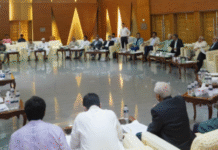At least 30 people were injured in police actions using water cannons and tear gas against anti-Rampal protesters who marched towards the Indian High Commission in Dhaka on Tuesday to submit a letter to the Indian prime minister for scrapping the coal-fired power plant project at Rampal near the Sunderbans.
A huge contingent of police in riot gears, backed by water cannons, armoured personnel carriers and prison vans, swooped on the protesters, cordoning them off in between Mauchak intersection and Malibagh level crossing.
After the incident, a five-member delegation was
escorted by cops to the Indian High Commission. The delegation handed over the letter to a high commission official, who, however, declined to acknowledge the receiving, protesters said.
Witnesses said that National Committee to Protect Oil, Gas, Mineral Resources, Power and Ports started the march from National Press Club at about 11:30am.
Police guarded the protesters including eminent educationist Serajul Islam Choudhury, national committee convener Sheikh Mohammad Shahidullah, its member-secretary Anu Mohammad, also Jahangirnagar university professor, when they marched along the streets at Paltan, Bijoy Nagar, Shantinagar and Malibagh.
Scuffle broke out between the cops and protesters in Mouchak intersection, where the cops blocked the road at about 1:00pm.
The protesters broke the barricade and headed towards the high commission in Guslhan and faced police barricade near Malibagh level crossing, the witnesses said.
Police cordoned off the protesters in between Mauchak and Malibagh level crossing and used water cannons and tear gas from both sides keeping no way for the protesters to escape, the witnesses said.
Several protesters were seen limping off. They were being whisked off to safer places.
After about a 45-minute commotion, police were seen searching the nearby buildings to find out protesters. Police, however, said later that they held none.
Earlier on September 30, the ruling Awami League-backed student organisation Bangladesh Chhatra League and police attacked an anti-Rampal cycle procession in the capital.
Anu Muhammad said that police swooped on the protesters, fired gunshots and tear gas shells and used water cannons cordoning them off.
He said that 30 protesters were injured in the police actions.
Anu announced countrywide rally for October 20 protesting against the police attack and demanding cancellation of the Rampal power plant project.
Dhaka Metropolitan Police Ramna division deputy commissioner Maruf Hossain Sorder said that the protesters did not follow the police instruction to stop the procession at different points from the Press Club.
‘They even did not take any permission from us,’ he said, adding that police dispersed the protesters using water cannon and tear gas to maintain traffic and law and order.
Maruf said police fired no bullet. He claimed that several cops were injured, one critically, in assault by the protesters.
The police later escorted a five-member delegation of the national committee to the Indian high commission.
Writer Rahnuma Ahmed, who was in the delegation, told New Age that a high commission official took the letter declining to acknowledge in writing.
‘We don’t know the identity of the official, who took the letter’, she said.
Clarifying the reason to write to Modi, Anu said that earlier on July 28 they marched towards the Prime Minister’s Office, but they were attacked by law enforcers and their letter was not received.
‘We, however, sent the letter to prime minister Sheikh Hasina, but got no reply, rather different types of harassments upon the protesters were on since then,’ he said.
He said that they sent the letter to Indian prime minister through Indian high commission, as India was also a partner to the project.
The national committee and green activists are in the streets protesting against the coal-fired thermal power plant project, a joint initiative of Bangladesh and India, which, the campaigners said, would damage the world’s largest mangrove forest, Sunderbans.
Source: New Age










